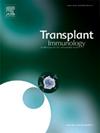Effectiveness of liver transplant mortality scales in a Mexican population
IF 1.4
4区 医学
Q4 IMMUNOLOGY
引用次数: 0
Abstract
Background
Liver transplantation is the treatment of choice in patients with chronic liver disease and acute liver failure of any etiology. Scales such as the Survival Outcome Following Transplantation (SOFT) score and the Balance of Risk (BAR) score can be used to predict survival. In this study, we compared these scales in the Mexican population.
Methods
A cross-sectional analytical study was carried out in a Mexican third-level transplant center. The MELD, SOFT, and BAR scales were adopted. The ROC curves of the three predictive scores were constructed, and the areas under the curve were obtained and compared. A bivariate analysis and Cox regression were performed. Finally, a survival analysis was performed using Kaplan–Meier curves.
Results
We analyzed 123 liver transplant (LT) recipients. The bivariate analysis and Cox regression indicated that portal thrombosis, with an HR of 3.36 (IC 1.069–10.59, p = 0.038), and the number of red blood cells transfused, with an HR of 1.084 (CI 1.039–1.130, p < 0.000), were significantly associated with mortality. The receiver height was a protective factor, with an HR of 0.001 (CI 0.000–0.761, p = 0.041). Regarding the Pearson correlation analysis, the BAR scale had a coefficient of 0.199 (p = 0.032) for transfusion, while the SOFT scale's correlation coefficients for cold ischemia and transfusion were 0.236 (p = 0.011) and 0.274 (p = 0.003), respectively, all indicating weak correlations. The areas under the curve (AUCs) of MELD, SOFT, and BAR in predicting 3-month mortality were 0.495 (P = 0.94), 0.608 (p = 0.129), and 0.502 (p = 0.97), respectively. Finally, in the survival analysis using Kaplan–Meier curves, an estimated mean survival period of 71.52 months was obtained, with a survival rate of 89.3 % at 30 days and 81.1 % at five years.
Conclusion
In this study, it was found that all three scales were deficient in discriminating among the outcomes obtained in the Mexican population.
墨西哥人群肝移植死亡率量表的有效性。
背景:肝移植是任何病因的慢性肝病和急性肝衰竭患者的治疗选择。移植后生存结局(SOFT)评分和风险平衡(BAR)评分等量表可用于预测生存。在这项研究中,我们在墨西哥人口中比较了这些量表。方法:在墨西哥三级移植中心进行横断面分析研究。采用MELD、SOFT、BAR量表。构建3种预测评分的ROC曲线,得到曲线下面积并进行比较。进行双变量分析和Cox回归。最后,使用Kaplan-Meier曲线进行生存分析。结果:我们分析了123例肝移植(LT)受者。双变量分析和Cox回归分析显示,门静脉血栓形成的HR为3.36 (IC 1.069 ~ 10.59, p = 0.038),输注红细胞数的HR为1.084 (CI 1.039 ~ 1.130, p )。结论:本研究发现,三个量表在墨西哥人群中获得的结局中都存在区分不足。
本文章由计算机程序翻译,如有差异,请以英文原文为准。
求助全文
约1分钟内获得全文
求助全文
来源期刊

Transplant immunology
医学-免疫学
CiteScore
2.10
自引率
13.30%
发文量
198
审稿时长
48 days
期刊介绍:
Transplant Immunology will publish up-to-date information on all aspects of the broad field it encompasses. The journal will be directed at (basic) scientists, tissue typers, transplant physicians and surgeons, and research and data on all immunological aspects of organ-, tissue- and (haematopoietic) stem cell transplantation are of potential interest to the readers of Transplant Immunology. Original papers, Review articles and Hypotheses will be considered for publication and submitted manuscripts will be rapidly peer-reviewed and published. They will be judged on the basis of scientific merit, originality, timeliness and quality.
 求助内容:
求助内容: 应助结果提醒方式:
应助结果提醒方式:


